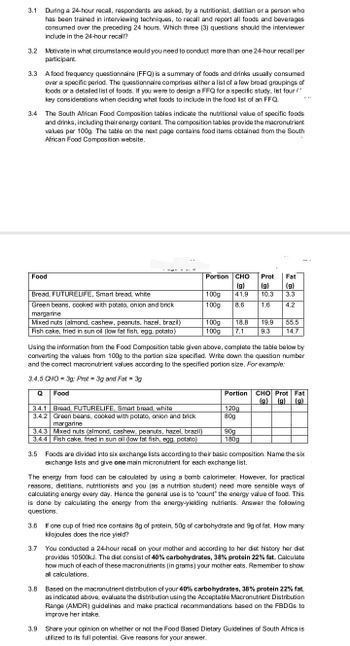Question

Transcribed Image Text:3.1
3.2
3.3
3.4
During a 24-hour recall, respondents are asked, by a nutritionist, dietitian or a person who
has been trained in interviewing techniques, to recall and report all foods and beverages.
consumed over the preceding 24 hours. Which three (3) questions should the interviewer
include in the 24-hour recall?
Motivate in what circumstance would you need to conduct more than one 24-hour recall per
participant.
A food frequency questionnaire (FFQ) is a summary of foods and drinks usually consumed
over a specific period. The questionnaire comprises either a list of a few broad groupings of
foods or a detailed list of foods. If you were to design a FFQ for a specific study, list four (
key considerations when deciding what foods to include in the food list of an FFQ.
The South African Food Composition tables indicate the nutritional value of specific foods
and drinks, including their energy content. The composition tables provide the macronutrient
values per 100g. The table on the next page contains food items obtained from the South
African Food Composition website.
Food
-g-
Bread, FUTURELIFE, Smart bread, white
Green beans, cooked with potato, onion and brick
margarine
Mixed nuts (almond, cashew, peanuts, hazel, brazil)
Fish cake, fried in sun oil (low fat fish, egg, potato)
3.7
3.4.1 Bread, FUTURELIFE, Smart bread, white
3.4.2 Green beans, cooked with potato, onion and brick
margarine
3.4.3 Mixed nuts (almond, cashew, peanuts, hazel, brazil)
3.4.4 Fish cake, fried in sun oil (low fat fish, egg, potato)
Portion CHO Prot Fat
(g)
(g)
(g)
41.9
10.3
3.3
1.6
4.2
100g
100g 8.6
100g
100g 7.1
18.8
Using the information from the Food Composition table given above, complete the table below by
converting the values from 100g to the portion size specified. Write down the question number
and the correct macronutrient values according to the specified portion size. For example:
3.4.5 CHO = 3g; Prot 3g and Fat = 3g
Q
Food
19.9
9.3
120g
80g
55.5
14.7
|
Portion CHO Prot Fat
(g) (g) (g)
90g
180g
3.5 Foods are divided into six exchange lists according to their basic composition. Name the six
exchange lists and give one main micronutrient for each exchange list.
The energy from food can be calculated by using a bomb calorimeter. However, for practical
reasons, dietitians, nutritionists and you (as a nutrition student) need more sensible ways of
calculating energy every day. Hence the general use is to "count" the energy value of food. This
is done by calculating the energy from the energy-yielding nutrients. Answer the following
questions.
3.6
If one cup of fried rice contains 8g of protein, 50g of carbohydrate and 9g of fat. How many
kilojoules does the rice yield?
You conducted a 24-hour recall on your mother and according to her diet history her diet
provides 10500kJ. The diet consist of 40% carbohydrates, 38% protein 22% fat. Calculate
how much of each of these macronutrients (in grams) your mother eats. Remember to show
all calculations.
3.8 Based on the macronutrient distribution of your 40% carbohydrates, 38% protein 22% fat,
as indicated above, evaluate the distribution using the Acceptable Macronutrient Distribution
Range (AMDR) guidelines and make practical recommendations based on the FBDGS to
improve her intake.
3.9 Share your opinion on whether or not the Food Based Dietary Guidelines of South Africa is
utilized to its full potential. Give reasons for your answer.
Expert Solution
This question has been solved!
Explore an expertly crafted, step-by-step solution for a thorough understanding of key concepts.
Step by stepSolved in 3 steps

Knowledge Booster
Similar questions
- What are the dietary recommendations regarding concentrated sugar intakes? no handwritten answers, please.arrow_forwardWhat is the purpose of Glucose test? For Carbohydrates Metabolism : of Glucose during lab?arrow_forwardwhat is the difference between nutrient claims, health claims, and structure-function claims?arrow_forward
- Below is a simple set of weights obtained while immersing potato slices in various sugar solutions over 30 minutes.!!! For each solution, calculate the rate of weight change over this 30-minute period. Write your answer in standard notation and use 3 digits past the decimal point - e.g. 0.005, 0.030. (Note that the last zero in an answer is considered to be a digit). Show your work with all the calculations I really need the right answer please 0.0 M sucrose = _______ _____________ g/min 0.4 M sucrose = _______ _____________ g/min 0.6 M sucrose = __________________ g/min 0.8 M sucrose = ____________________ g/min 1.0 M sucrose = ____________________ g/minarrow_forwardHow do you calculate dosages safely?arrow_forward
arrow_back_ios
arrow_forward_ios